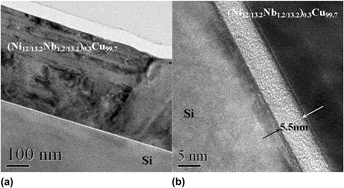Crossref Citations
This article has been cited by the following publications. This list is generated based on data provided by
Crossref.
Li, Xiao Na
Zhao, Li Rong
Li, Zhen
Liu, Li Jun
Bao, Cui Min
Chu, Jinn P.
and
Dong, Chuang
2014.
Barrierless Cu–Ni–Nb thin films on silicon with high thermal stability and low electrical resistivity– ERRATUM.
Journal of Materials Research,
Vol. 29,
Issue. 4,
p.
605.
Li, Xiaona
Ding, Jianxin
Wang, Miao
Chu, Jinn P.
and
Dong, Chuang
2014.
Application of cluster-plus-glue-atom model to barrierless Cu–Ni–Ti and Cu–Ni–Ta films.
Journal of Vacuum Science & Technology A: Vacuum, Surfaces, and Films,
Vol. 32,
Issue. 6,
Li, X.N.
Wang, M.
Zhao, L.R.
Bao, C.M.
Chu, J.P.
and
Dong, C.
2014.
Thermal stability of barrierless Cu–Ni–Sn films.
Applied Surface Science,
Vol. 297,
Issue. ,
p.
89.
Zheng, Yuehong
Li, Xiaona
Jin, Lujie
Zhang, Kun
and
Dong, Chuang
2015.
Effects of distribution and growth orientation of precipitates on oxidation resistance of Cu–Cu12–[Crx/(12+x)Ni12/(12+x)]5 alloys.
Journal of Materials Research,
Vol. 30,
Issue. 21,
p.
3299.
Wang, L.
Jin, L.
Yu, L. H.
Dong, S. T.
Chen, J.
and
Xu, J. H.
2016.
Evaluation of electric field intensity on atom diffusion of Cu/Ta/Si stacks during annealing.
Applied Physics A,
Vol. 122,
Issue. 1,
Li, X.N.
Liu, M.
Zheng, Y.H.
Sun, W.
and
Dong, C.
2017.
Addition of strong interaction element Fe(or Sn) to improve the stability of solid solution Cu(Ge) film.
Surface and Coatings Technology,
Vol. 321,
Issue. ,
p.
328.
Zheng, Y.H.
Li, X.N.
Cheng, X.T.
Sun, W.
Liu, M.
Liu, Y.B.
Wang, M.
and
Dong, C.
2018.
Ni-V(or Cr) Co-addition Cu alloy films with high stability and low resistivity.
Materials Chemistry and Physics,
Vol. 205,
Issue. ,
p.
253.
Zheng, Yuehong
Li, Xiaona
Cheng, Xiaotian
Li, Zhuming
Liu, Yubo
and
Dong, Chuang
2018.
Enhanced thermal stability of Cu alloy films by strong interaction between Ni and Zr (or Fe).
Journal of Physics D: Applied Physics,
Vol. 51,
Issue. 13,
p.
135304.
Wang, Wenweijiao
Wang, Jian
Li, Shangjin
Wang, Chen
Zhou, Jianhui
Zeng, Jiawei
Tan, Wenlong
and
Wang, Bingshu
2022.
Effects of Nb addition on the properties and microstructure of Cu-Ni-Si-Mg alloy.
Materials Characterization,
Vol. 194,
Issue. ,
p.
112451.
